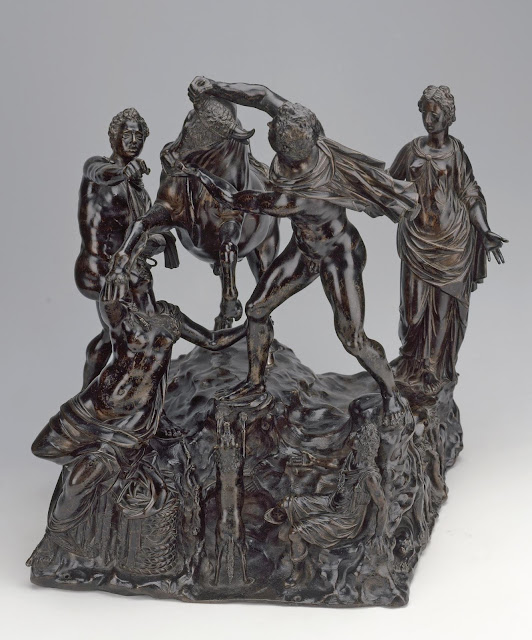 |
| Carlo Albacini copy of the Head of the Apollo Belvedere ca. 1750-1800 marble Hermitage, Saint Petersburg |
 |
| Benedetto Pistrucci copy of the Head of the Apollo Belvedere early 19th century sardonyx cameo Hermitage, Saint Petersburg |
 |
| Anonymous French sculptor copy of the Apollo Belvedere at the Vatican 18th century bronze statuette Hermitage, Saint Petersburg |
The canon of sculptural masterpieces surviving from antiquity took shape in Rome during the 16th century. By the 18th century a core group of about eighty distinct statues had come to represent the unquestioned dogma of ideal beauty for all of educated Europe. Thousands of copies proliferated in every conceivable medium. Those seen here are the copies that ended up in the Russian imperial collections. All are now owned by the State Hermitage Museum in Saint Petersburg, but many are no longer on display. The prestige of the originals began to fade in the middle of the 19th century, and has continued to fade. Naturally enough, the prestige of the copies has faded further.
 |
| Stefano Maderno copy of the Laocoön at the Vatican 1630 terracotta statuette Hermitage, Saint Petersburg |
 |
| Paolo Andrea Triscornia copy of the Laocoön at the Vatican 1798 full-size marble Hermitage, Saint Petersburg |
 |
| Paolo Andrea Triscornia copy of Sleeping Ariadne (or Cleopatra) at the Vatican ca. 1775-1800 full-size marble Hermitage, Saint Petersburg |
 |
| Francesco Righetti copy of Meleager at the Vatican 1788 bronze statuette Hermitage, Saint Petersburg |
 |
| Anonymous Italian sculptor in Rome copy of Equestrian Marcus Aurelius in the Capitoline Museum, Rome ca. 1750-1800 bronze statuette Hermitage, Saint Petersburg |
 |
| Anonymous Italian sculptor copy of the Spinario in the Capitoline Museum, Rome 1560s bronze statuette Hermitage, Saint Petersburg |
 |
| Paolo Andrea Triscornia copy of the Dying Gladiator in the Capitoline Museum, Rome ca. 1775-1800 full-size marble Hermitage, Saint Petersburg |
 |
| Anonymous Italian sculptor copy of Capitoline Antinous at the Capitoline Museum, Rome ca. 1750-1775 bronze statuette Hermitage, Saint Petersburg |
 |
| Anonymous Italian sculptor in Florence copy of Gaul Killing Himself and His Wife (also known as Paetus and Arria) at Museo delle Terme, Rome ca. 1700-1725 bronze statuette Hermitage, Saint Petersburg |
 |
| Paolo Andrea Triscornia copy of the Apollino in the Tribuna of the Uffizi, Florence ca. 1775-1800 full-size marble Hermitage, Saint Petersburg |
 |
| Anonymous Italian sculptor copy of the Apollino in the Tribuna of the Uffizi, Florence ca. 1700-1750 full-size bronze Hermitage, Saint Petersburg |
 |
| Paolo Andrea Triscornia copy of Germanicus at the Louvre ca. 1775-1800 full-size marble Hermitage, Saint Petersburg |
 |
| Carlo Albacini copy of Castor and Pollux at the Prado ca. 1775-1800 full-size marble Hermitage, Saint Petersburg |
 |
| Anonymous Italian sculptor copy of the Farnese Hercules in Naples ca. 1775-1800 full-size marble Hermitage, Saint Petersburg |
 |
| Antonio Susini copy of the Farnese Bull in Naples 1613 bronze statuette Hermitage, Saint Petersburg |
Francis Haskell and Nicholas Penny researched and described in detail the rising and sinking fortunes of the originals of each of these statues in their indispensable study, Taste and the Antique (Yale, 1981).